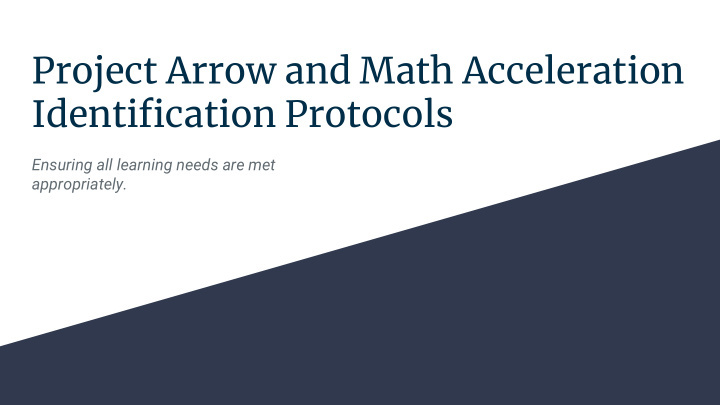



Project Arrow and Math Acceleration Identification Protocols Ensuring all learning needs are met appropriately.
Project Arrow Fall: Screening and Initial Data Review Identification Administration of Cognitive Abilities ● Process Test (CogAT) to all 2nd graders - October File review - November/December ● Standardized Tests ○ District Assessments ○ Review of classroom observation data - ● November/December
Project Arrow Winter: Data Collection Identification Consent for Testing Letters sent to ● Parents of selected students Process recommended for further testing - January - as determined by: CogAT Screening Scores ○ Classroom Assessments ○ Student artifacts ○ Teacher/Parent input ○ Administration of Achievement Test ● (IOWA) for selected students - January
Project Arrow Spring: Data Analysis Identification Completion of Student Profile Sheet - ● March/April Process School Academic Team Placement ● Review Discussions - April School team extensively reviews ○ all relevent information for students who fall in the ‘Review’ category.
Project Arrow Spring: Decision Identification Qualification Notification Letters to ● Parents - April Process Optional Parent Requested Placement ● Review Meeting for students whose scores fall in the review range. Purpose of the meeting is for parents to provide the school team with data/work samples from outside of school - April/May Final placement decision rests with the ● school academic team.
Math Acceleration Identification Process Fall: Administration of Cognitive Abilities Test (CogAT) to all 2nd graders - October ● Spring: Parent Notification of Accelerated Math Testing - February ● District Placement Test for Accelerated Math - March ● Consideration of Data - April ● Parent Notification of Placement - April ●
Cognitive Abilities Test CogAT
2nd Grade CogAT Assesses students abilities in Verbal Reasoning, Quantitative Reasoning, and ● Nonverbal Reasoning Untimed ● Multiple Choice ● Students mark answers in the test booklet ● Tests are scored using national percentiles ●
CogAT Assesses ability to use search, ● retrieval, and comparison process Verbal Reasoning Subtest include ● Verbal Classification ○ Sentence Completion ○ Verbal Analogies ○ Focus on vocabulary, ● comprehension, and word relationships
CogAT Assesses ability to reason with ● patterns and relations Quantitative Subtest include ● Reasoning Qualitative Relations ○ Number Series ○ Relation Building ○ Focus on abstract reasoning and ● problem solving
CogAT Assesses ability to reason with ● novel questions that use spatial Nonverbal and figural content. Reasoning Subtest include ● Figure Classification ○ Figure Analogies ○ Figure Analysis ○
IOWA Achievement Test
IOWA Achievement Test Subtests in Reading and Mathematics ● Timed - All subtests are 30 minutes or less ● Multiple Choice ● Students answer in the test booklet ● Tests scored using national percentiles ●
How do I prepare my child for the CogAT and/or IOWA Test? Research shows student test best when rested and relaxed Stress-free evening the night before ● Get plenty of rest ● Eat a good breakfast ● Encourage the to show their best without worry or pressure ●
Summary of 204 Enrichment Opportunities Grades K-2: Classroom Differentiation and Talent Development Grades 3-5: Classroom Differentiation, Math Acceleration*, and Project Arrow* Grades 6-8: Classroom Differentiation, Math Acceleration*, Project Arrow- Reading Strand*, and Project Arrow-Math* Grades 9-12: CLassroom Differentiation, Honors, Advanced Placement (AP), and Dual Credit Courses
Recommend
More recommend